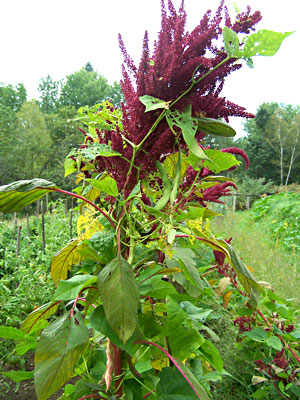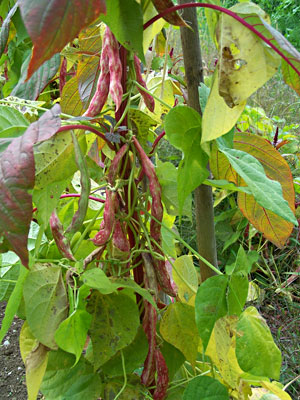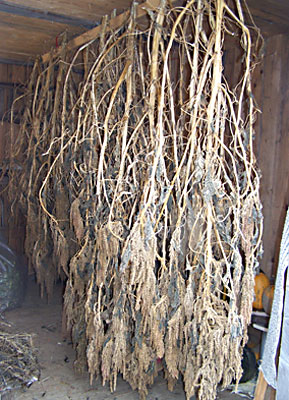 |
| An amaranth inflorescence. Amaranth produces nutritious seeds, and plants can be part of sustainable cropping systems. Photos by Will Bonsall. |
By Will Bonsall
Amaranth (Amaranthus cruentus) is a New World crop, a staple of the ancient Aztecs, who popped it and mixed it with honey to make a treat somewhere between marzipan and Cracker Jacks. In fact it was such a central part of their Precontact culture that the Spanish Conquistadores felt a need to ban its cultivation and consumption. I suppose it didn’t help that it was used in rituals, sometimes mixed with the blood of human sacrifices. Anyway, amaranth use went underground for centuries, grown and eaten in secret. Now its reputation has been thoroughly rehabilitated, due largely to its superior nutritional value and suitability for sustainable crop systems.
Amaranth is classed as a “pseudo-grain” because, although its culinary use is as a cereal, much like quinoa and buckwheat, it is not in the grass family (Poaceae), like wheat, rice, corn, etc. Moreover, amaranth is also used as a vegetable (again, like quinoa and buckwheat), its young leaves and shoots providing highly nutritious and tasty greens.
Wild Greens
My first experience with amaranth as a veggie was with its wild form, redroot pigweed, which I learned about as a kid from Euell Gibbons’ “Stalking the Wild Asparagus.” Even as a cultivated crop, it is vastly superior to spinach – slower to bolt, less demanding of soil nitrogen, and at least to my taste, better flavored (although in my opinion not as suitable for raw salads). In fact, although some cultivated amaranth varieties are bred for greens instead of grain, I rarely grow them, since the wild amaranth (pigweed) suits my purpose as well.
Of course pigweed will compete with the crop where the weed emerges. It rarely gets established before I mulch it out, but in my corn I often let some of the ubiquitous plants grow several inches high before I pinch off the tops to eat and then pull or chop in the remaining plants. After hilling the corn and undersowing a living much of ladino clover, the corn crop seems none the worse for the pigweed’s brief career, and I’ve squeezed some fine eating out of those areas long before the corn was ready.
I especially love to take blanched pigweed out of the freezer in midwinter and mix it with kale or mustard greens, sometimes blended into a cream soup with oat flour and pepita meal; not too shabby.
Growing for Grain
My main interest in amaranth is as a grain. Indeed Gibbons writes about using pigweed seed in muffins, but it has a strong taste, which prevents me from using much of it. Wild amaranth, as well as the cultivated greens types, has a shiny black seed coat that is packed with anthocyanin. That pigment is lovely in beets and other vegetables, but it is easily overdone. The grain amaranth types, on the other hand, have white or yellowish seed, which is much milder flavored.
 |
| Pole beans growing up amaranth stems. |
Start from Transplants
I usually grow only a couple of hundred plants, because that seems to yield enough for my needs – and because I start my plants in a cold frame or in my unheated greenhouse where I have limited space. Amaranth can be direct seeded and will do fine, but my favorite type, a tall variety from Michoacan, Mexico, called ‘Opopeo’, yields much better in a slightly longer season. I sow them in late April in #72 cell trays, thinning to a single plant in each cell. That gives them a two- or three-week head start, so they have some reasonable size when I set them out in mid-May.
Another reason to transplant is that amaranth seedlings are indistinguishable from redroot pigweed, and when direct-seeded, it is difficult to know which plants to pull. As they grow larger, the size and red color of amaranth make it stand out, but meanwhile they suffer from the competition.
Amaranth is quick to germinate but slow-growing at first, and the tiny, thread-like seedlings seem to take forever to get established, but once they get through that stage, their growth is almost explosive. For that reason, the seedlings are vulnerable to drought-stress, but once they strike root, they’re remarkably resilient.
Although newly transplanted, evenly spaced plants are easy to distinguish from any intermingled pigweed, the deer also appreciate them and are less careful to differentiate between the crop and the weeds. I sometimes exclude deer with electric tape, but often simply stretching a piece of string around the patch about 4 feet high is enough of a deterrent. I may also stretch string right in the row over the young plants. As absurd as it sounds, I’ve often found this quite effective for small patches. Of course deer can easily step over the strings, but apparently the feeling of being in a confined space where anything might impede their retreat makes them skittish. For larger areas this method is useless.
Intercropping Possibilities
I space rows 3 feet apart and set plants at least a foot apart, but usually 1-1/2 to 2 feet. The wider spacing reduces the yield only slightly if at all, due to increased branching, and it gives a benefit that far outweighs any loss. You see, I never plant amaranth by itself, any more than corn or sunflowers; instead I grow a companion crop with it. In the case of amaranth, that crop is dry pole beans. (My favorites for this are ‘Orlando’s’, a local heirloom, large horticultural type, and ‘Roark’, a pole form of pinto.) Beans are very frost-tender and I cannot reliably sow them before Memorial Day, by which time the amaranth is already a few inches tall, which is ideal. If the amaranth plants hadn’t reached that fast-growing stage yet, the rampant bean vines would have overtaken them and had nothing to climb. The beans will suffer from the increasing shade of the amaranth – I find they yield about 75 percent of what they would if grown on bare poles – but the amaranth is unaffected, for better or worse, so whatever I get from the beans is a bonus.
Commercially, the preferred amaranth varieties, such as ‘Plainsman’, are shorter, somewhat earlier, and uniform in maturity, which is important for using a grain combine. But in my intensive garden, there’s no advantage, since I give them that head start, plus the shorter varieties are unsuitable for companioning with pole beans. If I were growing a large acreage and using machinery, I would direct-seed ‘Plainsman’.
 |
| Amaranth in the curing/drying shed. |
By the way, I grow only dry beans with my amaranth; pole string beans would do just as well, but harvest would be more of a nuisance among the amaranth foliage. Dry beans can be left to harvest at the same time as the grain crop, when repeated frosts have killed the foliage, and the vines and pods are plainly visible.
Harvest
Amaranth is fairly frost-hardy at both ends of the season and is ready for harvest in early October. However, leaving the plants a few weeks longer allows the later-formed seed heads to ripen and cure properly. No matter how late they stand in the field, amaranth plants contain a lot of moisture, especially the main stalks, some of which could grade out for sawlogs. I like to hang the plants from beams in the shed for several weeks longer to get them perfectly dry for easier threshing. To accelerate that drying process, I don’t cut the whole plants but lop them off 3 feet high; any side-branch seed-heads below that I lop off separately. Later I pull the lower stalks for compost – no easy matter!
I have stripped off the bean pods long before this, and the remaining dried leaves can be ignored. In fact there are always a few missed pods, which get dried and threshed along with the grain. The dried beans get sifted out when cleaning the grain crop, including some beans that were at the green-shell stage at harvest time but have further ripened in the slight frost protection of the amaranth plants.
Ornamental Too!
Although I am growing amaranth as a utilitarian food crop, the plants are highly ornamental, with their majestic stalks and bright magenta flower heads. (Some varieties are grown specifically for ornament.) Even when ripening to a rusty red, the carmine-streaked bean pods (‘Orlando’s’) also add a striking accent to the otherwise drab October garden.
Squeezing in a Green Manure
By the way, I’m not satisfied with growing two crops on the same land. When I grow food for myself, I’m always looking for ways to grow food for the soil as well. Any green manure grown at the same time as a crop (a “living mulch”) must not compete with that crop. My favorite is clover, especially ladino, which I sow in early July, right after I do a final cultivation in the form of hilling the amaranth (not too deeply; the highly aerobic bean roots need to breathe). I do the first shallow cultivation with a wheel hoe in mid-June, soon after the plants are well established and while the weeds are tiny.
Incidentally, the idea that the leguminous clover will help the main crop is a myth. In its first year, the associated bacteria-filled nodules fix nitrogen for the host plant (clover); the nitrogen benefits the edible crop the following year, when the clover is chopped in. On the other hand, the clover will not be competing with the crop for available soil nitrogen, so at worst the impact is neutral, while the overall effect is wholly beneficial.
In the beginning the ladino is not altogether happy with the arrangement; it muddles along grumpily, making a beachhead in the gathering shade of the amaranth. You can almost hear it grumble. But in the fall, as the bean and amaranth foliage freezes off, the hardy clover looks around and concludes that life is good after all. It makes the most of the waning days of autumn, putting on modest growth. That alone would be well worth it, but I demand more. Left over winter, the clover will revive in early spring and make renewed growth, and if I follow the amaranth with a late-planted crop such as tomatoes, then the second growth of clover will be substantial when I chop it in, basically giving me two half-seasons of clover growth where I could not have gotten a full one.
Threshing and Winnowing
Amaranth is difficult to thresh with a flail, but I don’t try to. Rather I lay down the dry plants on a tarp on the barn floor, largely parallel, and do a scuffling “chicken-dance” crosswise (perpendicular to the stalks). The seed is very hard and small, so I believe I could thresh it in my chipper/shredder, but for my quantity it’s not worth the effort of carefully cleaning the drum before and after.
After threshing it looks like a pile of rusty-pink fluff, which it mostly is, but after winnowing (I pour it back and forth between two buckets in a light breeze) I find a smaller pile of tiny white seeds. That’s disappointing when you consider all the space and plant mass that went into producing it, but heft that grain and you may feel better – only plutonium is denser. It becomes obvious why this stuff is reputed to be so nutrient-packed. The complete protein (unlike grains or legumes), the abundance of easily assimilated minerals (calcium, iron, potassium, zinc, copper and magnesium); yep, the heft alone tells you that’s all in there.
Using Seeds and Flour
I use some whole amaranth seed in roasts, veggie-burgers and casseroles, or mixed with other whole grains such as rice or cracked wheat, but mostly I use it as flour. A single pass through my Corona hand-mill leaves it largely unscathed, or at least it will look little changed, but much of it will have been cracked, and a second or third grinding will look more like a fine meal. I usually give it three or four passes between the steel burrs, which fortunately is quick and easy. Then I use it in muffins (go easy; they don’t need much, and amaranth flour will make them heavy) and in pancakes. In our eggless vegan waffles, amaranth gives a crispy richness, which even the kids love, mixed with oat flour and sunflower meal and all that other stuff that their daddy grows out there in the dirt.
About the author: Will Bonsall lives in Industry, Maine, where he directs Scatterseed Project, a seed-saving enterprise. His book on gardening and homesteading was published by Chelsea Green. You can contact Will at [email protected].
